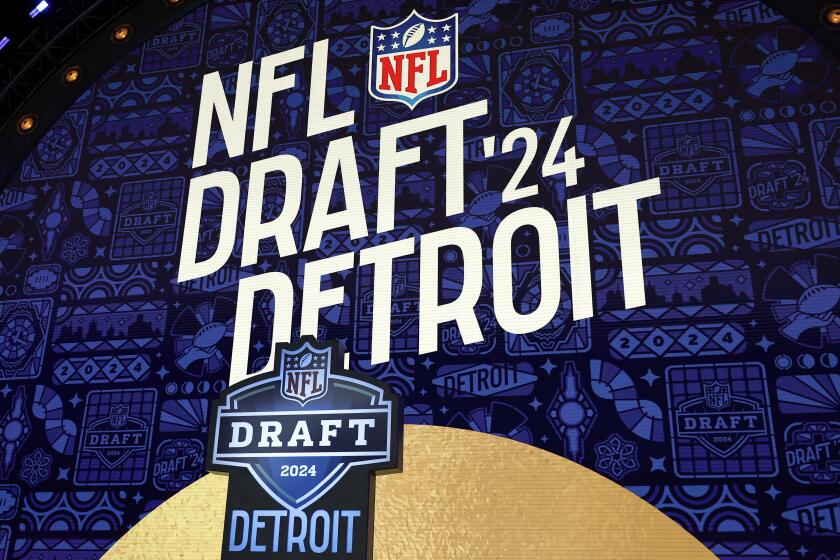Launching into view
TUCKED in a secluded cove off the surf track in Laguna Beach, maverick swell stalkers jockey for waves, which they’ll catch, not by paddling but by sprinting smack into them. It’s surfing as head-on collision, using a device that for most arbiters of studly endeavor has been about as daring as a bike with training wheels -- the skimboard.
The leader of the kamikaze pack, wiry, tousle-haired Bill Bryan, 32, studies the incoming ridges, then bolts for the surf as if chased by an enraged rhino. In mid-sprint he tosses the board ahead of him on the wet sand, leaps on and glides into the teeth of a 4-foot shore break. He zooms up the face of the wave to the lip, where he flips the board about-face and carves back down toward shore. He gets a second or two in the barrel before it closes out and crunches him in barely 2 feet of water.
“It’s basically a train wreck or a ballet dance, depending on your timing,” he says afterward, salt water beading down his body. “You need to get going as fast as you can so you don’t sink or stick to the sand. You just come at it and smash it.”
And sometimes a few other things. Bryan has four screws and a metal plate in one ankle and gets dinged up most days because there’s not much of a net in the high-wire act of wave skimming, which is done in the shallow water of shore breaks.
His moves are something you’d expect on a skateboard, not a plywood disk for ferrying rug rats, the image most have of skimboards and one that Bryan does his wave-walking best to dispel. “That’s what most people think it is,” says Bryan. He’s topped the world skim championships 12 out of the last 15 years, but his exploits haven’t won him the recognition or big bucks of his peers in the surf scene because his field gets all the deference of shuffleboard.
“Sliding along on the sand on a piece of plywood isn’t very respectable,” he adds. “But if you come down here and the sidewash is working, it’s more exciting than surfing. It takes skateboarding into the water.”
Skimboards aren’t your dad’s stray chunk of lumber anymore and haven’t been for a couple of decades, since foam-core boards allowed wave skimmers to launch acrobatics the equal of anything in the skate- or snowboard realm. Yet skimming has remained a fringe pursuit, making it a rare breed in the hypercommercial surf and X Game era: a board sport that’s still owned by the kids who do it.
On a postcard summer afternoon, Bryan and the second-place finisher at this year’s world championships, Tyler Lopez, 21, and a posse of other hard-core skimmers, several seen on MTV’s reality show “Laguna Beach: The Real Orange County,” dish out a jaw-dropping series of spins, midair board grabs and floaters (balancing atop the crest of the wave) for an audience that’s pretty much just themselves. Fixated on the next set, they don’t seem to mind that they’re running with surfing’s poor cousin.
“It’s still grass roots,” says Bryan. “That’s part of the reason we do it and don’t surf. It’s more fun and rewarding to be a part of than what a lot of the forces of culture are telling me to do with my body and my life.”
But Bryan and his friends may have company soon. Skimboarding shows signs of shaking off the sand-squirt image and catching a breakout from obscurity. In the last few years a handful of companies, including surf and mass-market firms, have entered the market; production of boards in China is lowering costs; a boating market has opened up for skimming on wakes; and “Laguna Beach” has put skimming, and several of the kids who carve with Bryan, in the national spotlight.
That could mean bigger paydays for skim pioneers who have labored long in the trenches, like Bryan, who makes skim DVDs to help supplement his contest winnings. And especially for Tex Haines, a Laguna skimmer who founded Victoria Skimboards, the first bona fide company in the field, 29 hair-raising years ago and has been waiting for the sport to take off ever since.
But as much as Bryan and Haines want the higher profile, they’re wary of the price of acceptance -- cutthroat competition, an invasion of the neighborhood. Bryan worries about the “bro factor” slipping away as it did in surfing when the megabucks hit, while Haines admits he’s “never been in a hurry to get big overnight.”
There’s no choice now. Skimboards are coming to a big-box store near you.
*
The disk evolves
HUMANS have been devising ways to get out from under the yoke of gravity for years, with sliding -- on snow, mud, water or wet sand -- a favorite antidote to biped boredom. So it was only a matter of time before skimming freed the species from lock step.
Laguna lifeguards came up with the first prototypes in the 1920s, putting a glide in their strides with 20-pound wooden disks. That became the standard shape into the ‘60s, when boards began to evolve from oblong to sled-like and shield-style to today’s sleek high-performance models, which resemble smaller, wider surfboards without fins. Laguna has remained the epicenter of the skim universe, thanks to the configuration of its shoreline, where a drop-off brings waves nearly to the sand before they break. The formation makes Laguna lousy for surfing but great for skimming.
Haines spent summer weekends as a kid at Laguna’s Victoria Beach, where his parents (who both surfed, his mom getting lessons from surfing legend Duke Kahanamoku) shared a beach cottage with other families. He started “skidboarding,” as it was called then, and quickly found himself under the spell of the slide.
“It’s frictionless, it’s cool, it’s wet, and you’d just do that all day long in between bouts of eating,” he recalls. He was supposed to be a doctor, like everyone in his family. But after graduating from Stanford with a degree in biology, he heard the call, instead, to minister to stationary beachgoers. He and a friend launched Victoria Skimboards in 1976 in a garage above the beach of his youth.
Victoria became the standard-bearer for the skim scene, moving design from the scrap lumber model into the direction of surfboards, using foam core and carbon-fiber materials to build lightweight, highly maneuverable devices that allowed skimmers to not just glide but ride waves. Haines had the market to himself for years, with a respected product and the chief spotlight as sponsor of the Victoria Pro-Am World Championships. He figured it would take five years for the company to become profitable, but he didn’t know his calculation would turn out to be in dog years.
At one point he got stuck with too much inventory, and he and his wife had to move back in with his parents until he sold the boards. To stoke the market, he started a skim publication that cost him thousands of dollars before he had to fold it. There were more rough spots in the ‘90s, when skimboarding dipped after a rise in the ‘80s. The closest call came when a huge workers’ compensation bill for his 27 employees combined with a 50% increase in the cost of materials almost finished off his company earlier this year, just as demand was taking off. It was a particularly low blow after he’d weathered so many hits.
“I was having a hard time emotionally because I felt like after all these years, what did I do? How did I blow this?” says Haines, in Victoria business attire -- shorts and sandals -- on the porch of his Laguna Canyon store and office. He’s weary, but he hasn’t lost his will. “The only way to fail is to quit,” says Haines, who has more stick-to-itiveness than a factoryful of Elmer’s glue.
Like all bootstrap entrepreneurs, Haines has been hamstrung by a lack of capital to grow his business and market his boards. He’s only had sales reps the last couple of years. But his dilemma also stems from the sketchy fortunes of skimboarding itself. Unlike surfing or boogie boarding, skimming hasn’t been an automatic next big beach thing. It takes more of a learning curve than lying on your belly. And a $200-plus price tag for foam-core boards put a lid on mass sales. “I look at the surfing magazines and their awards and the worshiping of their heroes and fame, and I go, ‘Dude, I’m a little bummed that we’re not recognized by surfing.’ When I grew up, surfers were the most open-minded people I knew.”
If skimboarding is 25 years behind surfing, as Haines sees it, it’s because it’s a much smaller market, says Steve Pezman, former editor of Surfer who now publishes Surfer’s Journal. He points to a limited number of top wave-skimming sites like Laguna. “Skimming is a subculture within a subculture, except that surfing’s gone mainstream and skimboarding’s still subterranean. But it’s more fun to be part of a subterranean thing than a mainstream thing.”
Haines, who’s in favor of having more financial fun, moves about 10,000 boards a year on sales of $1.5 million in a market he estimates at 100,000 skimboards annually. Meanwhile, the surf industry rakes in $4.7 billion from boards and clothing, according to Fortune Small Business magazine.
But after years of scraps at the surf feast, skimboarding is on a trajectory for at least some snacking -- growing 25% this year, as has Victoria, says Haines. He had a bustling first season selling Chinese boards and has been able to bring the price down on his entry-level foam-core board to $150 (wood boards start at $69). A half-dozen competitors have entered the field in the last two years. Mass market giant Wham-O has come out price-slashing, and surf companies like BZ have brought their cachet to the mix.
Yet it’s not surfers who are driving the shift in skim fortunes as much as the shredding affinity of landlubbers trained on the concrete waves of skate ramps.
*
Skating meets surf
BACK at Bryan’s cove, the track meet is in high gear. One by one, Bryan, Lopez and Sam Ferguson, who skims in the background footage of every “Laguna Beach” episode, charge down a steep sand berm, gunning for the main attraction, a sidewash that lets them catch waves farther out for longer and more tricked-out rides. As a wave rebounds off the cliff that arcs around this mansion-topped hideaway and peels laterally across the surf zone, Bryan tears for it, jumping on his board and sailing 20 yards across the suds, sideways at times, into the froth of this helper wave. The liquid escalator drops him onto the shoulder of the main break, where he swerves into the barrel, and it’s showtime. He carves down the wave, tosses in a 360, then turns sharply for the lip in a bid to grab his board in midair, but the wave closes out and launches him into foamy flight.
Skimming’s arsenal of skateboard moves, such as floaters (the water version of rail slides) and shove-it grabs, and its nonstop action -- skimmers can catch 50 shore-break waves on a day when a surfer might get only six decent outside curls -- is a marriage made in attention-deficit heaven for ramp-rolling kids. Skateboarders can bust a few skim moves right away, says Bryan, but it would take a surfer a month of practice, working at it every day.
The crossover bodes well for skimming making a leap out of its California and Florida hubs. Waves and oceans are not required; most skimming is done on flat water. Skimming is showing up inland, on lakes and rivers in places like Scottsdale, Ariz., and St. George, Utah, and boaters are using skimboards for freeboarding on wakes, in which riders let go of the tow rope and surf the wave.
Like skateboarding, skimming translates pent-up adolescent energy into acrobatic fidgeting, with a premium on the rush of improvisation. In “Liquid Courage,” one of 20 skim highlight films Bryan says he’s done with film-grad brother George, Bryan surges off the sidewash at the Wedge in Newport, then in mid-ride bumps into a boogie board floating up the wave, leaps off his skimboard onto the boogie and finishes the ride bodyboarding. Cirque du Soleil couldn’t do it better.
“It’s the most insane and radical fleeting sport you can find,” says Bryan. “It’s such a split-second decision between land, air and water that it really gives you the release.”
Even surfers are noticing. The owner of a surf shop in Hawaii recently told Pezman he can’t keep Victoria skimboards in stock. “I said, ‘Do you want me to take you by and introduce you to Tex Haines?’ And he went, ‘Oh, yeah.’ This is George Downing, a surf god, one of the pioneers of the big wave board, being all excited about me introducing him to the domo of the skimboard.”
*
Fundamental fun
TO escape the ambiguities of the skim business, Haines heads down to the beach a couple of times a week to slide it out of his system. “You throw it down, jump on it, whoa! Your hair goes back, your sense of acceleration is there, maybe you fall, maybe a wave smacks you. Pure fun,” he says.
It’s that “fundamental funness” of the sport that’s kept him going all these years, something he’s demonstrating today at Aliso Beach. The burdens of competitors seem to melt away as he nears the shoreline. He’s soon absorbed in the language of ripples, reading the ocean for a cross-shore line to take him to his launchpad. Then he’s pounding for his board. He leaps on and planes up the face of a luminous turquoise curl, which catapults him into his favorite old-school move, a back flip minus board high over the wave.
“I love it -- being launched!” he says.
It’s practice for his biggest move. The risk-taking skimmer and cautious businessman are about to trade places. With a hand from business manager Trigg Garner, Haines will debut three new boards next year and dramatically increase imports of lower-priced models from China to supplement local production. He expects a fivefold bump in sales next year as a result.
Timing is everything for the skimmer. And the skimboard entrepreneur. Haines eyes the surf for a break, and he can see it now. “We’re only just beginning,” he says. And then he’s running for his wave.
More to Read
Get our high school sports newsletter
Prep Rally is devoted to the SoCal high school sports experience, bringing you scores, stories and a behind-the-scenes look at what makes prep sports so popular.
You may occasionally receive promotional content from the Los Angeles Times.






